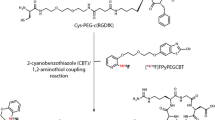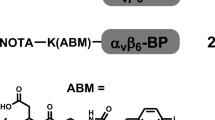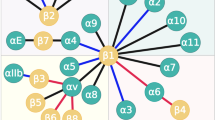Abstract
Purpose
Integrins are transmembrane receptors responsible for cell–cell adhesion and cell–extracellular matrix binding and play an important role in angiogenesis and tumour metastasis. For this reason, integrins are increasingly used as targets for molecular imaging. Up to now interest has mostly been focused on the integrin subtype αvβ3. However, targeting of other subtypes such as the integrin α5β1 is also of high interest due to its central role in colonization of metastatic cells, resistance of tumour cells to chemotherapy and ionizing radiation, and tumour aggressiveness. Recently, a highly active antagonist ligand (2,2′-(7-(1-carboxy-4-((6-((3-(4-(((S)-1-carboxy-2-(2-(3-guanidinobenzamido)acetamido)ethyl)carbamoyl)-3,5-dimethylphenoxy)propyl)amino)-6-oxohexyl)amino)-4-oxobutyl)-1,4,7-triazonane-1,4-diyl)diacetic acid, FR366) for the integrin subtype α5β1 with high selectivity versus αvβ3, has been developed and tested successfully in preliminary in vitro and in vivo experiments. Here, we present our results of an investigation of the use of 68Ga-labelled α5β1 ligand in PET imaging.
Methods
The free α5β1 peptidomimetic ligand was functionalized with a spacer (6-aminohexanoic acid) and the bifunctional chelator 1-((1,3-dicarboxy)propyl)-4,7-(carboxymethyl)-1,4,7-triazacyclononane (NODAGA) to yield FR366 and labelled with 68Ga. To confirm selective in vivo targeting of α5β1, female BALB/c nude mice xenografted with α5β1-expressing RKO cells in the right shoulder and α5β1/αvβ3-expressing M21 cells in the left shoulder were subjected to PET/CT scans and biodistribution experiments. Specificity of tracer uptake was proven by blocking studies. Metabolic stability of the injected tracer was measured in urine and in plasma.
Results
MicroPET/CT scans with radiolabelled FR366 showed a good tumour-to-normal tissue ratio with low uptake in the liver (0.32 ± 0.14 %ID/g) and good retention of 68Ga-NODAGA-FR366 in the tumour (0.71 ± 0.20 %ID/g and 0.40 ± 0.12 %ID/g for RKO and M21 tumours, respectively, at 90 min after injection). Biodistribution experiments showed uptake in the α5β1-expressing RKO tumour of 1.05 ± 0.23 %ID/g at 90 min after injection. Specificity of tracer uptake was demonstrated by injection of 5 mg/kg unlabelled ligand 10 min prior to tracer injection, resulting in a 67 % reduction in uptake in the RKO tumour. The tracer was found to be metabolically stable in urine and plasma 30 min after injection.
Conclusion
Our results show that PET imaging of α5β1 expression with the 68Ga-labelled α5β1-specific ligand is feasible with good image quality. Thus, FR366 is a promising new tool for investigating the role of α5β1 in angiogenesis and the influence of this integrin subtype on cancer aggressiveness and metastatic potential.






Similar content being viewed by others
References
Desgrosellier JS, Cheresh DA. Integrins in cancer: biological implications and therapeutic opportunities. Nat Rev Cancer. 2010;10(1):9–22.
Harburger DS, Calderwood DA. Integrin signalling at a glance. J Cell Sci. 2009;122(Pt 2):159–63.
Hynes RO. Integrins: bidirectional, allosteric signaling machines. Cell. 2002;110:673–87.
Shattil SJ, Kim C, Ginsberg MH. The final steps of integrin activation: the end game. Nat Rev Mol Cell Biol. 2010;11(4):288–300.
Thumshirn G, Hersel U, Goodman SL, Kessler H. Multimeric cyclic RGD peptides as potential tools for tumor targeting: solid-phase peptide synthesis and chemoselective oxime ligation. Chemistry. 2003;9(12):2717–25.
Meyer A, Auernheimer J, Modlinger A, Kessler H. Targeting RGD recognizing integrins: drug development, biomaterial research, tumor imaging and targeting. Curr Pharm Des. 2006;12:2723–47.
Schottelius M, Laufer B, Kessler H, Wester HJ. Ligands for mapping alphavbeta3-integrin expression in vivo. Acc Chem Res. 2009;42(7):969–80.
Goodman SL, Picard M. Integrins as therapeutic targets. Trends Pharmacol Sci. 2012;33(7):405–12.
Aumailley M, Gurrath M, Müller G, Calvete J, Timpl R, Kessler H. Arg-Gly-Asp constrained within cyclic pentapeptides. Strong and selective inhibitors of cell adhesion to vitronectin and laminin fragment P1. FEBS Lett. 1991;291(1):50–4.
Dechantsreiter MA, Planker E, Mathä B, Lohof E, Hölzemann G, Jonczyk A, et al. N-Methylated cyclic RGD peptides as highly active and selective alpha(V)beta(3) integrin antagonists. J Med Chem. 1999;42(16):3033–40.
Mas-Moruno C, Rechenmacher F, Kessler H. Cilengitide: the first anti-angiogenic small molecule drug candidate design, synthesis and clinical evaluation. Anticancer Agents Med Chem. 2010;10(10):753–68.
Haubner R, Wester H-J, Burkhart F, Senekowitsch-Schmidtke R, Weber W, Goodman SL, et al. Glycosylated RGD-containing peptides: tracer for tumor targeting and angiogenesis imaging with improved biokinetics. J Nucl Med. 2001;42(2):326–36.
Gruner SA, Locardi E, Lohof E, Kessler H. Carbohydrate-based mimetics in drug design: sugar amino acids and carbohydrate scaffolds. Chem Rev. 2002;102(2):491–514.
Haubner R, Bruchertseifer F, Bock M, Kessler H, Schwaiger M, Wester HJ. Synthesis and biological evaluation of a (99m)Tc-labeled cyclic RGD peptide for imaging the alphavbeta3 expression. Nuklearmedizin. 2004;43(1):26–32.
Haubner R, Kuhnast B, Mang C, Weber WA, Kessler H, Wester HJ, et al. [18F]Galacto-RGD: synthesis, radiolabeling, metabolic stability, and radiation dose estimates. Bioconjug Chem. 2004;15(1):61–9.
Haubner R, Weber WA, Beer AJ, Vabuliene E, Reim D, Sarbia M, et al. Noninvasive visualization of the activated alphavbeta3 integrin in cancer patients by positron emission tomography and [18F]Galacto-RGD. PLoS Med. 2005;2(3):e70.
Beer AJ, Haubner R, Goebel M, Luderschmidt S, Spilker ME, Wester HJ, et al. Biodistribution and pharmacokinetics of the alphavbeta3-selective tracer 18F-galacto-RGD in cancer patients. J Nucl Med. 2005;46(8):1333–41.
Beer AJ, Haubner R, Sarbia M, Goebel M, Luderschmidt S, Grosu AL, et al. Positron emission tomography using [18F]Galacto-RGD identifies the level of integrin alpha(v)beta3 expression in man. Clin Cancer Res. 2006;12(13):3942–9.
Garmy-Susini B, Varner JA. Integrins in angiogenesis and lymphangiogenesis. Nat Rev Cancer. 2008;8(8):604–17.
Robinson SD, Hodivala-Dilke KM. The role of β3-integrins in tumor angiogenesis: context is everything. Curr Opin Cell Biol. 2011;23(5):630–7.
Kim S, Bell K, Mousa SA, Varner JA. Regulation of angiogenesis in vivo by ligation of integrin alpha5beta1 with the central cell-binding domain of fibronectin. Am J Pathol. 2000;156(4):1345–62.
Barkan D, Kleinman H, Simmons JL, Asmussen H, Kamaraju AK, et al. Inhibition of metastatic outgrowth from single dormant tumor cells by targeting the cytoskeleton. Cancer Res. 2008;68(15):6241–50.
Kato H, Liao Z, Mitsios JV, Wang HY, Deryugina EI, Varner JA, et al. The primacy of β1 integrin activation in the metastatic cascade. PLoS One. 2012;7(10):e46576.
Park CC, Zhang HJ, Yao ES, Park CJ, Bissell MJ. Beta1 integrin inhibition dramatically enhances radiotherapy efficacy in human breast cancer xenografts. Cancer Res. 2008;68(11):4398–405.
Janouskova H, Maglott A, Leger DY, Bossert C, Noulet F, Guerin E, et al. Integrin α5β1 plays a critical role in resistance to temozolomide by interfering with the p53 pathway in high-grade glioma. Cancer Res. 2012;72(14):3463–70.
Rechenmacher F, Neubauer S, Polleux J, Mas-Moruno C, De Simone M, Cavalcanti-Adam EA, et al. Functionalizing ανβ3- or α5β1-selective integrin antagonists for surface coating: A method to discriminate integrin subtypes in vitro. Angew Chem Int Ed Engl. 2013;52(5):1572–5.
Neubauer S, Rechenmacher F, Beer AJ, Curnis F, Pohle K, D’Alessandria C, et al. Selective imaging of the angiogenic relevant integrins ανβ3 and α5β1. Angew Chem Int Ed Engl. 2013;52(44):11656–9.
Neubauer S, Rechenmacher F, Brimioulle R, Di Leva FS, Bochen A, Sobahi TR, et al. Pharmacophoric modifications lead to superpotent αvβ3 integrin ligands with suppressed α5β1 activity. J Med Chem. 2014;57(8):3410–7.
Pohle K, Notni J, Bussemer J, Kessler H, Schwaiger M, Beer AJ. 68Ga-NODAGA-RGD is a suitable substitute for 18F-Galacto-RGD and can be produced with high specific activity in a cGMP/GRP compliant automated process. Nucl Med Biol. 2012;39(6):777–84.
Hodivala-Dilke K. alphavbeta3 integrin and angiogenesis: a moody integrin in a changing environment. Curr Opin Cell Biol. 2008;20(5):514–9.
Heckmann D, Meyer A, Laufer B, Zahn G, Stragies R, Kessler H. Rational design of highly active and selective ligands for the α5β1 integrin receptor. Chembiochem. 2008;9(9):1397–407.
Friedlander M, Brooks PC, Shaffer RW, Kincaid CM, Varner JA, Cheresh DA. Definition of two angiogenic pathways by distinct alpha v integrins. Science. 1995;270(5241):1500–2.
Friedlander M, Theesfeld CL, Sugita M, Fruttiger M, Thomas MA, Chang S, et al. Involvement of integrins alpha v beta 3 and alpha v beta 5 in ocular neovascular diseases. Proc Natl Acad Sci U S A. 1996;93(18):9764–9.
Hodivala-Dilke KM, McHugh KP, Tsakiris DA, Rayburn H, Crowley D, Ullman-Culleré M, et al. Beta3-integrin-deficient mice are a model for Glanzmann thrombasthenia showing placental defects and reduced survival. J Clin Invest. 1999;103(2):229–38.
Reynolds LE, Wyder L, Lively JC, Taverna D, Robinson SD, Huang X, et al. Enhanced pathological angiogenesis in mice lacking beta3 integrin or beta3 and beta5 integrins. Nat Med. 2002;8(1):27–34.
Bader BL, Rayburn H, Crowley D, Hynes RO. Extensive vasculogenesis, angiogenesis, and organogenesis precede lethality in mice lacking all alpha v integrins. Cell. 1998;95(4):507–19.
George EL, Georges-Labouesse EN, Patel-King RS, Rayburn H, Hynes RO. Defects in mesoderm, neural tube and vascular development in mouse embryos lacking fibronectin. Development. 1993;119(4):1079–91.
Fässler R, Meyer M. Consequences of lack of beta 1 integrin gene expression in mice. Genes Dev. 1995;9(15):1896–908.
Decristoforo C, Hernandez Gonzalez I, Carlsen J, Rupprich M, Huisman M, Virgolini I, et al. 68Ga- and 111In-labeled DOTA-RGD peptides for imaging of alpha v beta 3 integrin expression. Eur J Nucl Med Mol Imaging. 2008;35(8):1507–15.
White DP, Caswell PT, Norman JC. alpha v beta3 and alpha5beta1 integrin recycling pathways dictate downstream Rho kinase signaling to regulate persistent cell migration. J Cell Biol. 2007;177(3):515–25.
Shi F, Sottile J. Caveolin-1-dependent beta1 integrin endocytosis is a critical regulator of fibronectin turnover. J Cell Sci. 2008;121(Pt 14):2360–71.
Manavski Y, Carmona G, Bennewitz K, Tang Z, Zhang F, Sakurai A, et al. Brag2 differentially regulates β1- and β3-integrin-dependent adhesion in endothelial cells and is involved in developmental and pathological angiogenesis. Basic Res Cardiol. 2014;109(2):404.
Haubner R, Maschauer S, Einsiedel J, Eder IE, Rangger C, Gmeiner P, et al. H-CRRETAWAC-OH, a lead structure for the development of radiotracer targeting integrin α5β1? Biomed Res Int. 2014;2014:243185. doi:10.1155/2014/243185.
Schmieder AH, Caruthers SD, Zhang H, Williams TA, Robertson JD, Wickline SA, et al. Three-dimensional MR mapping of angiogenesis with alpha5beta1(alpha nu beta3)-targeted theranostic nanoparticles in the MDA-MB-435 xenograft mouse model. FASEB J. 2008;22(12):4179–89.
Acknowledgments
We thank Christina Lesti, Rosel Oos and Marianna Kallinger for technical assistance (cell culture and animal handling), Martina Anton and Edelburga Hammerschmid for help with the FACS analysis and Sybille Reder, Markus Mittelhäuser and Marco Lehmann for performing the animal PET/CT experiments.
Author contributions
C.D. optimized the FACS analysis protocol and measurements, elaborated and prepared the PET/CT images, performed the data analysis, and wrote the manuscript. K.P. carried out 68Ga-labelling, performed cell binding studies, the FACS analysis and in vivo experiments (biodistribution, metabolic stability, PET/CT analysis). S.N. and F.R. synthesized and characterized the integrin antagonist. J.N. and H.J.W. proof-read the manuscript and provided advice on 68Ga labelling. A.J.B. and M.S. were responsible for the molecular imaging experiments. A.J.B., M.S. and H.K. initiated and supervised the project. All authors contributed to writing and editing the manuscript.
Author information
Authors and Affiliations
Corresponding author
Ethics declarations
Funding
This work was carried out within the MOBITUM project P3 “Improved ligands for quantitative monitoring of integrin expression” (MOBITEC/MOBITUM 01EZ0826) at TU Munich and was supported partially by ERC grant MUMI, ERC-2011-ADG_20110310, by the SFB 824 project C5 “Evaluation of imaging of αVβ3 expression with PET for response assessment of antiangiogenic therapies” and the Center of Integrated Protein Science Munich (CIPSM). H.K. is grateful for financial support from the Center of Integrated Protein Science Munich (CIPSM) and from King Abdulaziz University KAU (grant no. HiCi/25-3-1432).
Conflicts of interest
None.
Ethical approval for animal studies
All animal experiments were approved by the “Regierung von Oberbayern” (animal permission no. 55.2-1-45-2531-94-10) and were performed in accordance with current animal welfare regulations in Germany.
Additional information
Calogero D’Alessandria and Karolin Pohle contributed equally to this work.
Rights and permissions
About this article
Cite this article
D’Alessandria, C., Pohle, K., Rechenmacher, F. et al. In vivo biokinetic and metabolic characterization of the 68Ga-labelled α5β1-selective peptidomimetic FR366. Eur J Nucl Med Mol Imaging 43, 953–963 (2016). https://doi.org/10.1007/s00259-015-3218-z
Received:
Accepted:
Published:
Issue Date:
DOI: https://doi.org/10.1007/s00259-015-3218-z




